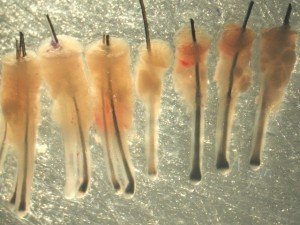A surgical procedure is a very delicate procedure which is technically challenging at almost every step. Relocating a large number of grafts takes cooperation between the doctor and his team. The follicular units (grafts) must be delicately handled to ensure they survive. It is a time-consuming process and it takes all day to relocate a large number of grafts.
The human head has collections of mostly one, two or three hair follicular units (grafts). Rarely, more than three hairs are found in one follicular unit. The human head has approximately 15-20% single hair grafts and 80-85% twos and threes.
Many clinics try to increase the graft yield by cutting the two and three hair grafts into single hair grafts. This does increase the number of grafts but it does not increase the amount of hair! Also, cutting a three hair graft into three singles may result in a decreased survival of that graft compared to leaving it in its natural state. Furthermore, most doctors believe that a large number of single hair grafts in a transplant decreases the density of the transplant. Many doctors agree that more than two or three hair grafts give a fuller look than a lot of single hair grafts.
It may even be tempting to “inflate” the graft count since it means charging more for the transplant but, as explained this may not yield better results. However, there are times when a doctor may use more singles as part of a specific design strategy.
So what is a reasonable number of grafts? The distance from ear to ear at the back of a person’s head averages between 25-30cm. The average density of human hair is between 50-120 follicular units per square centimetre. A little mathematical analysis reveals that on a new patient, who has never had surgery before, one can get 2500-3000 grafts. Many doctors believe that this is a good “safe” number. Taking a strip that is very wide can result in poor scar healing. Cutting follicular units into singles to increase the graft count also has potential problems such as decreased survival and less full appearance.
Some people with a lot of density can get very high graft counts. I would say that counts above 3500 usually mean taking out a very wide strip or increasing the graft count by splitting grafts.
I think it is time the public was informed. Do not be too “impressed” by the very large graft counts promised by one doctor. A good doctor should be able to mathematically explain why you need so many grafts and how such a high number will be achieved. Most doctors should be able to accurately estimate the graft yield. I explain to the patient that, in my hands, a ” mega session” means we take out as much hair as we safely can in one sitting. I can measure the back of the head (donor area) and then make estimates of graft count. Measuring the back of your head is a reproducible measurement that any doctor can perform. The number should be very similar between different doctors. In contrast, you will never be able to count the number of grafts a doctor says he will give you. You must rely on the doctor’s word.
The vast majority of doctors are honest hard-working people. However, I have noticed a tendency over the years for patients to tell me that “Dr X” promised me XXXXX (a very large number of grafts e.g. 4000, 5000, 6000, 7000). Often I tell the patient that this seems very unlikely to me in his case. Furthermore, it seems to me that in many patients, this large number of grafts would not even fit into the thinning area! Also, transplanting hair into an area that already has good density is a waste and may even damage healthy hair and make you look thinner!
So what to do? Make sure you have a chance to speak to the doctor. I myself use sales associates because of the high number of surgeries that I perform. Many of our patients are from out of town and out of the country. However, every patient is given a chance to speak to me directly or meet with me before surgery. Ask the doctor to explain how such a graft count will be achieved and if such a high count is necessary. After all, the donor supply is limited and you do not want to “waste” grafts.
If you shop around you may find that the count for each clinic just gets higher. Be sensible. It can get a little crazy for a patient who is trying to get a clear answer. I have performed many transplants over the years and I think we are reaching a time where the patients can be empowered with good information. Try to understand what it means to have a good high-quality hair transplant with the appropriate number of grafts. Try to understand that the donor area is a limited supply. Find a doctor you can talk to who seems to be honest and straightforward.













